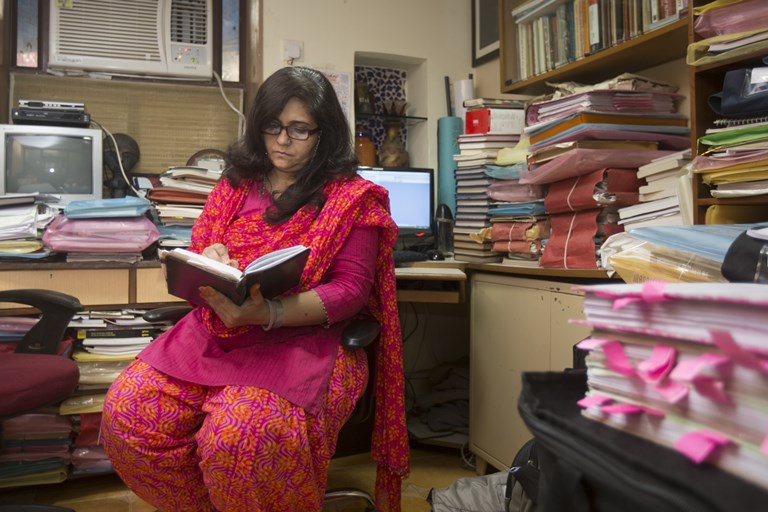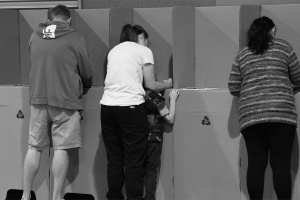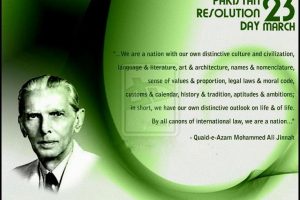By Sanjena Sathian (For Ozy)
It was Eid al-Fitr, the end of the Muslim holy month of Ramadan, and Muslims and non-Muslims alike thronged the streets of Mumbai. Billboards announced sales on shoes. Boys wore their finest taqiyahs. But at the southern tip of the city, in the Fort neighborhood, the factotums of the Central Bureau of Investigation were not observing this particular holiday. Instead, they plugged away at their jobs, which today required interrogation of the financial and official activities of one 53-year-old former journalist named Teesta Setalvad.
It had been a helluva a week for Setalvad and her husband, Javed Anand, one full of palling around with governmental friends. On Tuesday at eight a.m., 16 men arrived at their home in the plush western suburb of Juhu and stayed until the following morning, she says. They rifled through drawers and tromped through various rooms, hunting for proof that might jibe with the CBI’s designation of Setalvad as a “threat to national security.” The slightly squat activist, who runs a nongovernmental organization called Citizens for Justice and Peace and is a recipient of the nation’s prestigious Padma Shri Award, has quite the rap sheet. No fewer than three courts are considering a mélange of charges, according to documents: embezzling funds, illegally using foreign money and intentionally deceiving victims of bloody riots. In one of those courts, Setalvad is charged with uploading “objectionable” images to Twitter that apparently compared Hindu extremists with ISIS. Jail is a possibility; and in the interim, her passport remains in the hands of the court. (CBI representatives told OZY they had nothing more to add beyond the charges and “what had already been reported in the press.”)
On Saturday at the CBI, though, Setalvad and Anand seemed far less concerned with their own fates and much more interested in that of their prime minister, Narendra Modi. Talk wasn’t about their guilt — it was about his.
It has been 13 years since riots broke out in the northern state of Gujarat, the state of Setalvad’s ancestry, where Modi was then chief minister. Those riots saw fiery battles between Hindus and Muslims, and most reports show more Muslims were killed than Hindus. It has been one year since Modi took office, to much fanfare, in the world’s largest democratic elections ever. But in the time since the Gujarat riots, Modi’s critics have raised questions: As chief minister, could he and should he have done more to stop the violence? Does he have blood on his hands? The Bharatiya Janata Party — Modi’s party — has its answer: In 2012, India’s Supreme Court cleared him of all charges, and after his election, he inherited the international respect he had once been denied (the U.S. at last allowed him a visa; he’d been denied one for years).
But in a country that wants to move forward, to take its stand on center stage for the 21st century, Setalvad is someone who isn’t willing to lock away the past. She is the one who (unsuccessfully) called for the prime minister to be held liable in a criminal court for the Gujarat riots; and she continues to be critical of him. And in her view, she’s being targeted because of such criticisms. The financial charges over her NGO, she says, are just a way for the government to silence a dissident. Setalvad’s case, says Sudhir Krishnaswamy, law professor at Azim Premji University and visiting scholar at Columbia Law School, is one of a slew these days with “political overtones … Her case is being pushed with some purpose and direction.” In response, a representative from the Bharatiya Janata Party told us that if Setalvad is innocent, she “has nothing to fear.” The Ford Foundation, which funded one of Setalvad and Anand’s organizations and whose money the government alleges was misused, said in a statement to OZY that it is cooperating with the government’s investigation.

Source: Shailesh Andrade For OZY
All this, Krishnaswamy says, is a fine national drama, but one unlikely to result in a conviction for Setalvad. It is the narrative of it, the prosecution itself, the public debate that holds the power. “The prosecution is the punishment,” Krishnaswamy says. “Looking beyond Teesta, this may well shape what the future of civil society looks like, what it can and cannot do.” The political battleground is India’s booming mass media market, which activists fear is being increasingly censored; its vibrant social media feeds — where Modi, incidentally, is known for his Twitter savvy, and where Setalvad uploaded those Hindu deity pictures. The war will be won online, in the news, in the ink of reporters who sit now where Setalvad once sat.
So this is how the curtain opens on the latest act in the Teesta Setalvad Show, which itself is just another installment in the Saga of Modi’s India. Both stories have been building for much longer, though, and at this point, one might imagine that every new episode in the Setalvad Show, as Mark Twain might have put it, has a bit of a historical rhyme to it.
***
I sat with Anand first, and then Setalvad, as they rotated in and out of the questioning rooms at the dimly lit CBI office. They were offered coffee, politely, by the men in the waiting area, and referred to me as “a friend” keeping them company. We spoke in whispers. “They asked me my religion,” Setalvad confided to me, impishly. “I told the man interviewing me, ‘Humanist.’ He was very flustered. He said, ‘No, no, madam, you must say Hindu or Muslim. There is a format, madam.’” She seemed to take some glee in confounding a peon. With a cheeky grin, she pulled a long red book with gold-edged pages — a copy of the Indian Constitution — from her purse. She had kept it on the table during her interview, leisurely leafing through the pages while her interviewer went through his files.
We weren’t just reporters anymore. We were running mini control rooms, distress centers.
A short while later, Anand appeared. “He was a nice fellow,” he said amiably of his interviewer. They stepped out of the building, onto the sidewalk, and into a throng of 20 or 30 supporters. Setalvad looked out at 20 or 30 images of her own face, stuck onto red poster board, held up by bare-gummed activists. The slogans, lonely on the street full of oblivious passers-by, attempted grandiosity: Unite Against the Fascist Conspiracy! Stop Harassing Social Activists! In Solidarity With Teesta Setalvad! To a few concerned supporters, she quipped, with a snort, “They call me a threat to national security.” On this particular day, Setalvad wore blue floral-print pants, a black kurti top and scarf, and bright pink flip-flops; she gestured to herself as though to say, A threat, me?!
Then: “Shall we all go and have a chai?” she asked the group. And off everyone went, down the street to a historic Iranian bakery, to sip hot tea and eat sweet, soft bread and talk, as though at a dinner party, of the troubles assailing the nation.
Over tea in the bakery, funky-librarian glasses perched on her head, piercings (three ear and one nose) glinting, Setalvad matter-of-factly recalled that it was bakeries like these, Muslim ones, that she saw burned some 20 years ago. She speaks of it as though it were yesterday. A decade before Setalvad dispatched to Gujarat, she was part of a SWAT team of reporters that witnessed, recorded and functionally ran humanitarian operations during the so-called Bombay Riots. According to reports, about 900 people died — some Hindu, more Muslim — over the course of two months.
Except that, without Twitter, without clean phone lines, in a city full of blackouts, Setalvad and Anand found it hard to stay objective; people would call as the fire approached their doorstep, saying they had called the police, where was help? Often, it took Setalvad and the other reporters calling the cops to ask for comment before anyone arrived. “Fire all night, all morning,” is how she recalls it. “We weren’t just reporters anymore. We were running mini control rooms, distress centers.”
A day with Setalvad still feels much like that. She and Anand ride in a Jeep driven by government-provided armed guards, assigned to her after the Gujarat violence — they follow Setalvad everywhere and a team is on duty at her home at all times. She and Anand were warm and familiar with me, cramming me into the vehicle with them — close enough that we sweated on one another in the Mumbai heat — as we were ferried between the CBI, snacks with the supporters, and their lawyers’ office, where some 20 people awaited them like families awaiting the return of war veterans.
***
Setalvad was always going to touch justice, in some way. She seemed headed for law, at first; she is the granddaughter of the country’s first attorney general, from a family of prominent lawyers. She began legal studies, but dropped out to pursue journalism. It had caught her eye at a young age, when she watched the Watergate scandals from across the world. Perhaps more inevitable than justice, though, was Setalvad’s zest and occasional oddity. She called her father by his first name (“That was the essence of him”); at dinnertime there were rigorous discussions, and Dad assigned regular homework: Watch both the Hindi and English news at night, take notes, then brief him over breakfast. During Setalvad’s late teens, the Emergency — a period during which then-PM Indira Gandhi cracked down on civil liberties across the nation — was unfolding. Her father told her: “Forget your 10th-grade exams, and campaign.”
Once Setalvad finally dived into journalism, it was at the well-regarded newspaper The Daily, where Anand was the chief reporter. After some time, they became “involved” — no small happening, given that he is 13 years older. After their relationship began, Setalvad dipped out for The Indian Express, to keep things aboveboard. There, she began traveling to rural parts of the country for election coverage, and handled a few prominent law and justice stories. She also made a name covering the drought in the south of the desert-draped state Rajasthan, where farmers, cropless and helpless, had begun committing suicide. On she kept moving, to Business India — where she covered the Bombay Riots — and then, finally, somewhat inevitably, away from mainstream journalism and into the business of activist picketing and pamphleteering.
Anand and Setalvad launched a magazine, Communalism Combat, which enjoyed its first decade sandwiched between the Bombay Riots and the Gujarat pogroms. (It’s the umbrella organization of the magazine that received the Ford Foundation money and is now under investigation.) The next decade was filled with the aftermath of Gujarat — case after case of Setalvad seeking some retribution for the victims. She didn’t meet with much luck. Case after case flailed. Most prominent of all was the so-called Best Bakery case, in which a then-19-year-old Muslim charged that her family’s bakery had been burned to the ground — while they were inside. The 21 accused were let off when a court dismissed the case for lack of evidence. At the time, Amnesty International said the outcome confirmed the organization’s “worst fears” about the state government’s response to the violence. “Politicians are unwilling to give up control” over law enforcement, Krishnaswamy says. “Gujarat is an egregious example of that, but the structure is the same all over the country.”
At the end of this long day, I squeezed back in the couple’s Jeep, just me, them and the guards. We drove across the Mumbai sea link between city and suburbs, passing through the joyful mobs celebrating Eid al-Fitr, the ocean air breezing in. A few phone calls interrupted our conversation. One was from a Gujarat victim whom Setalvad speaks to often. “Don’t get upset, it’s all part of the battle we need to fight,” she told one caller. Then she hung up and turned back to me; I sat expectantly with my notepad out, still another part of her battle.
Aayush Soni contributed reporting.
This article was originally published here.




